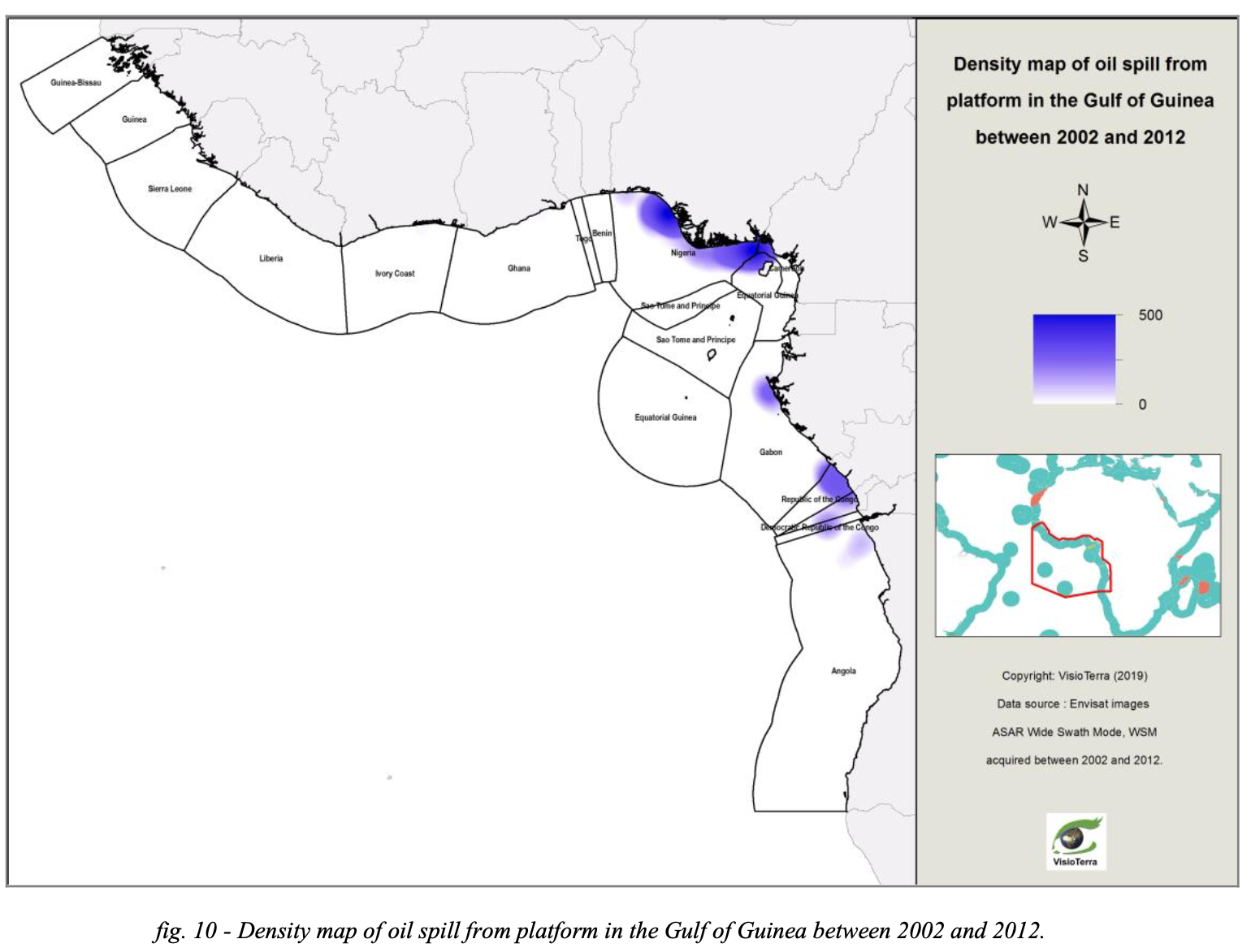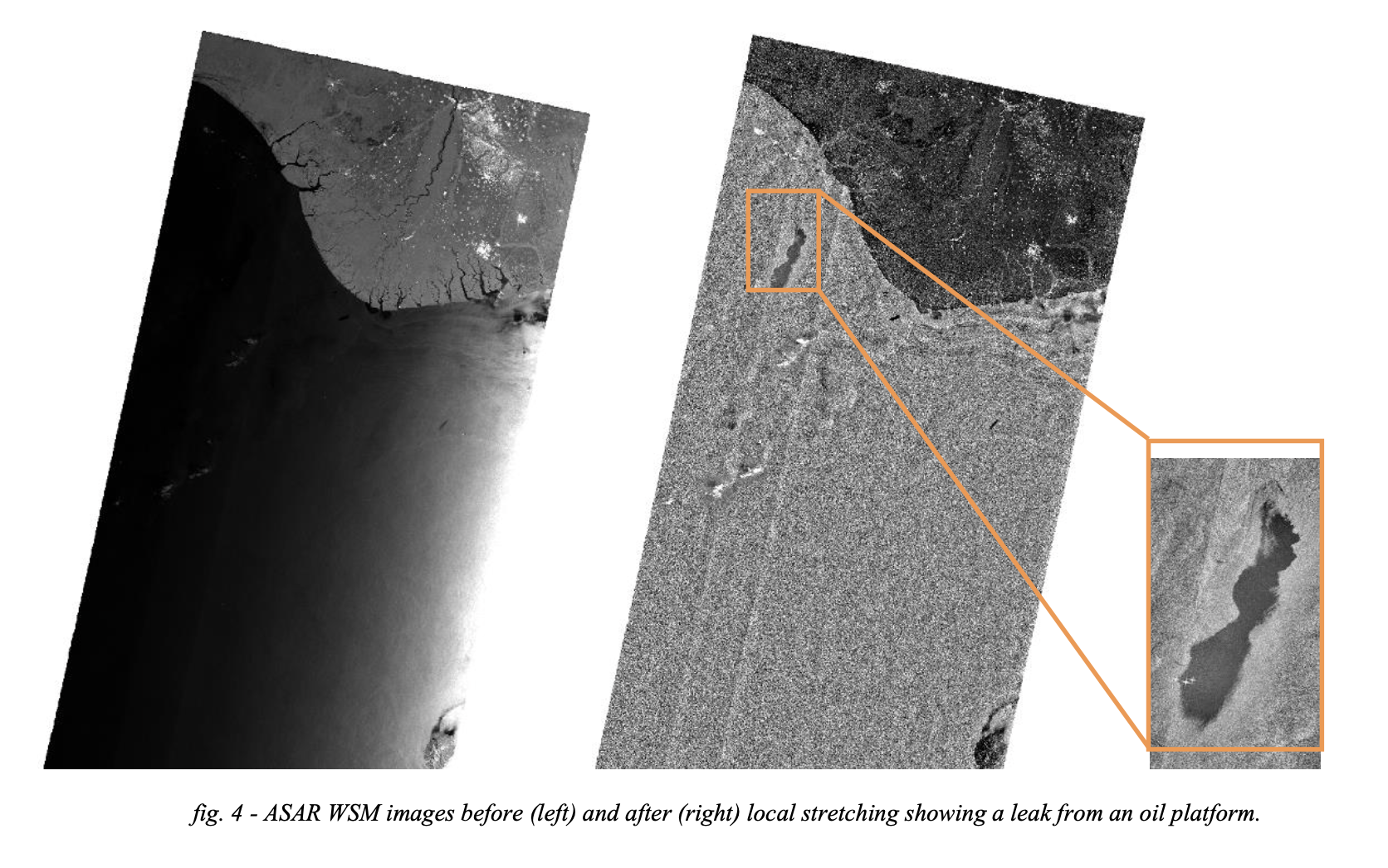Off West Africa’s coast, a sea of oil spills goes unreported
Dec 6, 2021
- In one of the first comprehensive studies of images captured by the Envisat satellite, researchers with French consultancy firm VisioTerra found evidence of 18,063 oil slicks in the Gulf of Guinea between 2002 and 2012.
- While some of the slicks were caused by natural seepages from oil-rich coastal areas, the bulk were tied to shipping and offshore oil production.
- Researchers told Mongabay the images suggest that the total amount of oil spilled into the Gulf of Guinea over the study period was greater than 2010’s Deepwater Horizon catastrophe, despite going largely unreported.
When BP’s Deepwater Horizon offshore oil rig flooded the Gulf of Mexico with 4 million barrels of oil in 2010, the catastrophe was headline news across the world for months. A new study of satellite images taken between 2002 and 2012 suggests that it may have been dwarfed by the amount of oil spilled into West Africa’s Gulf of Guinea in recent decades.
“There was a lot of news about what occurred in the Gulf of Mexico, which is good,” said Serge Riazanoff, one of the study’s authors and a researcher with VisioTerra, a French consultancy that specializes in satellite data assessments. “But nobody speaks about the fact that in the Gulf of Guinea it’s even worse.”
Riazanoff and his co-authors analyzed nearly 4,000 images of the West African coast taken by Envisat, a satellite launched by the European Space Agency in 2002 that recorded data across the world until it ceased functioning in April 2012. What they found when they started combing through those images to look for signs of oil spills was sobering.
According to the study, researchers were able to identify 18,063 oil slicks in the 10-year period covered by the images, mostly caused by spills from shipping vessels and offshore drilling platforms.


While some of the larger spills led to fines and penalties for companies like Shell and Exxon, Riazanoff said many others likely went unreported, particularly when they were relatively smaller or didn’t wash up onshore.
Images captured by Envisat’s advanced synthetic aperture radar (ASAR) were detailed enough to allow researchers to differentiate patterns of oil slicks from other oceanic events. Some slicks, called “seeps,” occurred naturally along parts of the coastline, but the bulk were caused by offshore drilling and exploration as well as deep-water de-ballasting by shipping vessels.
The worst period recorded in the study was 2008, when oil spills covered nearly 1,000 square kilometers (390 square miles) in the Gulf of Guinea over the course of the year, including around 400 km2 (155 mi2) of Angola’s coastal waters. Overall, Nigeria was far and away the most heavily affected country in the region.

Nigeria’s struggles with the environmental consequences of oil spills on shore have been well-documented, with the United Nations estimating in 2011 that cleaning up the heavily polluted Niger Delta region would take 30 years and cost billions of dollars. But less is known about the extent and severity of offshore spills — partly because the Nigerian government relies on oil companies themselves to disclose them.
“By law, when oil spills, the oil companies will indicate such,” said Idris Musa, director of Nigeria’s National Oil Spill Detection and Response Agency (NOSDRA).
But analysts say the Nigerian government lacks the ability to independently monitor its coastal waters on its own, and that often companies stay silent rather than risk taking a PR hit or being forced to pay for cleanup efforts.
“The reality is they don’t have the capacity to ascertain when there has been an oil spill,” said Ife Okafor-Yarwood, a lecturer at the University of St. Andrews in Scotland and an expert on the impact of oil pollution on coastal livelihoods in Nigeria. “They rely on the oil company that has access to a helicopter to take them there. The human capacity is there but they don’t have the assets.”
Musa told Mongabay that insecurity caused by piracy, a growing problem in recent years, has made it difficult for regulators to carry out unannounced monitoring visits to offshore platforms.
“Of course, [the companies] may not tell the truth, but you cannot go to any platform independently for now, for obvious reasons. We are in a place where we have a lot of illegal activities, nothing close to where we can go to any company’s platform to investigate so we don’t have mistaken identity,” he said.
Riazanoff said that in years past, VisioTerra has been hired by oil companies like France’s Total to monitor offshore oil spills — but only to warn them when those spills were headed toward the shoreline where regulators and the media were likely to take notice.
“We were monitoring the drift of oil slicks before they reach the beach where people would see it, but otherwise they don’t say anything,” he told Mongabay.
When those spills do arrive on shore, they can be catastrophic for coastal ecosystems and communities in the area.
“The impact is absolutely devastating, because it robs them of their livelihood, especially if they rely on fishing,” said Okafor-Yarwood.
According to Michael Watts, a professor emeritus of geography at the University of California, Berkeley, offshore oil spills can be caused by corporate negligence or illegal de-ballasting by shipping vessels, but also through leakage from theft and other forms of piracy.
“There’s a considerable amount of spillage that occurs with illegal loading at export terminals and offshore where a lot of barges lift and move oil,” he said.
Although the data analyzed by VisioTerra didn’t extend past 2012, Watts said it’s unlikely that much has significantly improved since then. As major oil producers move more of their operations in West Africa offshore, unless regulators are able to better monitor the industry’s compliance with environmental laws, the Gulf of Guinea will continue to suffer in silence.
“The pressure hasn’t been put on them, and for the most part the regulatory capacity and ability to enforce existing laws on the books vis à vis safety cleanup — certainly in Nigeria, but I would say virtually anywhere in the Gulf of Guinea — hasn’t improved,” he said.
Niger Delta communities in ‘great danger’ as month-old oil spill continues
Banner image: Oil spilling from the tanker M.V. Wakashio off the coast of Mauritius in 2020. Image courtesy of Greenpeace Africa.